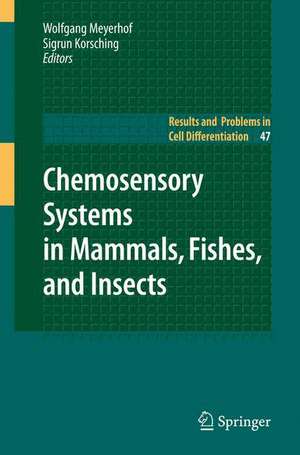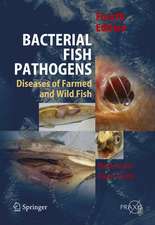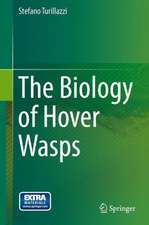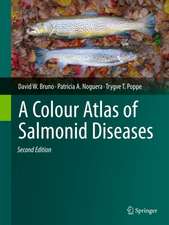Chemosensory Systems in Mammals, Fishes, and Insects: Results and Problems in Cell Differentiation, cartea 47
Editat de Wolfgang Meyerhof, Sigrun Korschingen Limba Engleză Hardback – 29 mai 2009
| Toate formatele și edițiile | Preț | Express |
|---|---|---|
| Paperback (1) | 1210.63 lei 6-8 săpt. | |
| Springer Berlin, Heidelberg – 19 oct 2010 | 1210.63 lei 6-8 săpt. | |
| Hardback (1) | 1224.36 lei 6-8 săpt. | |
| Springer Berlin, Heidelberg – 29 mai 2009 | 1224.36 lei 6-8 săpt. |
Din seria Results and Problems in Cell Differentiation
- 18%
 Preț: 1391.73 lei
Preț: 1391.73 lei - 15%
 Preț: 597.16 lei
Preț: 597.16 lei -
 Preț: 387.96 lei
Preț: 387.96 lei - 5%
 Preț: 373.33 lei
Preț: 373.33 lei -
 Preț: 382.18 lei
Preț: 382.18 lei -
 Preț: 385.08 lei
Preț: 385.08 lei - 15%
 Preț: 644.82 lei
Preț: 644.82 lei - 15%
 Preț: 634.00 lei
Preț: 634.00 lei -
 Preț: 387.20 lei
Preț: 387.20 lei -
 Preț: 387.75 lei
Preț: 387.75 lei - 15%
 Preț: 643.34 lei
Preț: 643.34 lei -
 Preț: 382.18 lei
Preț: 382.18 lei -
 Preț: 394.71 lei
Preț: 394.71 lei -
 Preț: 390.08 lei
Preț: 390.08 lei -
 Preț: 381.43 lei
Preț: 381.43 lei -
 Preț: 385.47 lei
Preț: 385.47 lei -
 Preț: 385.47 lei
Preț: 385.47 lei -
 Preț: 391.22 lei
Preț: 391.22 lei - 18%
 Preț: 1227.04 lei
Preț: 1227.04 lei - 20%
 Preț: 561.68 lei
Preț: 561.68 lei - 5%
 Preț: 1418.27 lei
Preț: 1418.27 lei -
 Preț: 386.00 lei
Preț: 386.00 lei -
 Preț: 377.95 lei
Preț: 377.95 lei -
 Preț: 391.61 lei
Preț: 391.61 lei -
 Preț: 388.52 lei
Preț: 388.52 lei - 18%
 Preț: 1380.63 lei
Preț: 1380.63 lei - 15%
 Preț: 639.25 lei
Preț: 639.25 lei - 18%
 Preț: 1220.12 lei
Preț: 1220.12 lei - 15%
 Preț: 642.51 lei
Preț: 642.51 lei - 15%
 Preț: 640.37 lei
Preț: 640.37 lei - 18%
 Preț: 1222.49 lei
Preț: 1222.49 lei - 18%
 Preț: 946.41 lei
Preț: 946.41 lei -
 Preț: 387.38 lei
Preț: 387.38 lei - 18%
 Preț: 1228.47 lei
Preț: 1228.47 lei - 15%
 Preț: 642.51 lei
Preț: 642.51 lei - 18%
 Preț: 1663.00 lei
Preț: 1663.00 lei - 18%
 Preț: 1225.62 lei
Preț: 1225.62 lei
Preț: 1224.36 lei
Preț vechi: 1493.13 lei
-18% Nou
Puncte Express: 1837
Preț estimativ în valută:
234.31€ • 254.43$ • 196.82£
234.31€ • 254.43$ • 196.82£
Carte tipărită la comandă
Livrare economică 22 aprilie-06 mai
Preluare comenzi: 021 569.72.76
Specificații
ISBN-13: 9783540699187
ISBN-10: 354069918X
Pagini: 280
Ilustrații: XVIII, 262 p. 46 illus., 25 illus. in color.
Dimensiuni: 155 x 235 x 23 mm
Greutate: 0.64 kg
Ediția:2009
Editura: Springer Berlin, Heidelberg
Colecția Springer
Seria Results and Problems in Cell Differentiation
Locul publicării:Berlin, Heidelberg, Germany
ISBN-10: 354069918X
Pagini: 280
Ilustrații: XVIII, 262 p. 46 illus., 25 illus. in color.
Dimensiuni: 155 x 235 x 23 mm
Greutate: 0.64 kg
Ediția:2009
Editura: Springer Berlin, Heidelberg
Colecția Springer
Seria Results and Problems in Cell Differentiation
Locul publicării:Berlin, Heidelberg, Germany
Public țintă
ResearchCuprins
Molecular Genetic Dissection of the Zebrafish Olfactory System.- The Receptor Basis of Sweet Taste in Mammals.- Odorant Receptor Gene Choice and Axonal Projection in the Mouse Olfactory System.- Extraordinary Diversity of Chemosensory Receptor Gene Repertoires Among Vertebrates.- Mammalian Bitter Taste Perception.- Gustation in Fish: Search for Prototype of Taste Perception.- Orosensory Perception of Dietary Lipids in Mammals.- Pheromone Sensing in Mice.- Smelling, Tasting, Learning: Drosophila as a Study Case.- Insect Olfaction: Receptors, Signal Transduction, and Behavior.- The Molecular Evolution of Teleost Olfactory Receptor Gene Families.- Genomics of Olfactory Receptors.
Textul de pe ultima copertă
The sense of smell has varied roles in locating food, detecting predators, navigating, and communicating social information, whereas the taste system is focused on decision-making in food intake. The last decade has witnessed massive advances in understanding the molecular logic of chemosensory information processing, and the results for taste sensation were found to differ in interesting ways from those for smell sensation. The 12 chapters of this book cover the current knowledge about the chemosensory systems in mammalian, fish and insect models. The advantages of the different model systems are emphasized. The genomic characteristics and evolution of olfactory and gustatory receptor gene families are analyzed, rules for odorant receptor gene choice and axonal projection of the corresponding receptor neurons are discussed, and the similarities and dissimilarities of pheromone vs. odorant sensing are examined as well as the molecular logic of mammalian sweet taste, bitter taste, and fat perception. Olfactory-guided and taste-guided behaviors are discussed, with a particular emphasis on the insect system.
Caracteristici
The present book serves as an up to date reference written by leading experts in the fields of olfaction and gustation Includes supplementary material: sn.pub/extras









